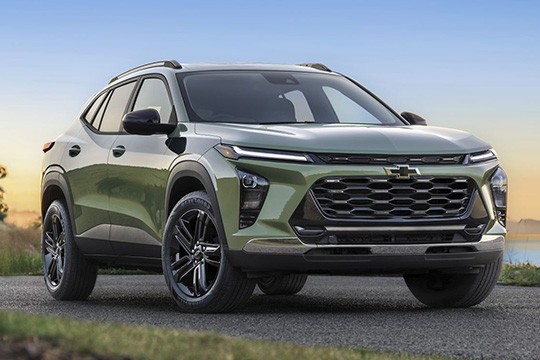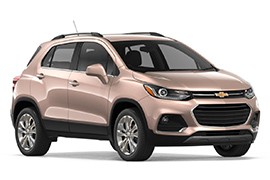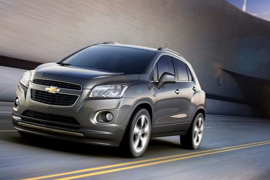CHEVROLET Trax Models/Series Timeline, Specifications & Photos
First production year: 2013
Engines: Gasoline, Diesel
Body style: Hatchback
Chevrolet introduced the Trax nameplate in 2013 as a badge-engineered Opel/Vauxhall Mokka based on the same platform as a European small-segment vehicle, the Opel/Vauxhall Corsa.
Fast forward nine years, and the bow-tie brand unveiled an entirely new Trax developed for the North American market. Surprisingly, it was bigger and less expensive than the model it replaced. In addition, it was better designed. Last but not least, it was ready for electrification.
Introduced as a 2024 model year, the second generation of the Trax was 11 inches (28 cm) longer, two inches (5 cm) wider, and four inches (10 cm) lower than the model it replaced. The overall design resembled its bigger brother, the Blazer. It featured the same slim line of LED daytime running lights mounted high above the bumper. At the same time, the headlights were positioned lower on the vertical side slats. The massive grille took center stage and was crossed by a bar supporting the Chevrolet badge.
Inside, the Trax came fitted with a standard 8” infotainment screen placed atop the center stack, with an option for an 11” unit. For the latter option, the automaker offered an 8” instrument cluster to go with it. There were five trim levels, and the upper ones featured man-made leather upholstery, a power driver seat, heated seats, and a sunroof.
The Trax came with an inline-three turbocharged engine that lost some power compared with its predecessor. Moreover, it was paired with a six-speed automatic instead of a nine-speed or a CVT offered for the first-generation Trax. Despite that, the 2024 Trax was quicker on the 0 to 60 mph (0-97 kph) run than the model it replaced.
As the 2015 version was beginning to look dated, Chevrolet redesigned it and unveiled it to the public in 2017.
The new design made the Trax look more attractive and possible one of the most desired crossover available on the market at the time.
For 2017, the most notable changes were made to the front end, that was significantly restyled to offer a much cleaner and sophisticated look: the headlamps became thinner and had a distinctive shape, with LED strips incorporated, feature that most seen rather on the more expensive vehicles. The front grille was also redesigned and became bigger.
Lots of changes were made to the interior, the cabin being modernised and updated with softer materials and new contrast stitchings for the upper trim levels.
The new multimedia system came with Apple Car Play and Android auto incorporated, fact that helped users to use the phone navigation by displaying the direction on the new touchscreen.
Other than that, the cabin was fitted with multiple USB ports, and the most interesting technology, buyers could use the 4G LTE connection to have a WI-FI hotspot available in the car. While the 4G LTE connection required a subscription, it was offered for free for a time-limited period.
The dashboard was completely redesigned and featured chrome accents, however, the redesign brought less storage spaces, as most of them were located on the dashboard.
The changes offered a more upscale feeling inside, however, there were a few downsides regarding the cluster gauges. While the previous version came with a digital speed-o-meter that was styled after a motorcycle, the new version was a basic tachometer and speedometer.
The 2017 Trax came with more available advanced safety features than the previous version.
Chevrolet pulled back from the European market, but it didn't leave empty-handed; it took the Gamma II platform, also used for the mundane Sonic and the European Opel Mokka.
When the SUV and crossover market exploded, General Motors already had a huge experience in those fields on all continents. Thus, it just made sense to provide something for everybody. In Europe, it made the Opel Mokka, which was translated in the U.S. as Chevrolet Trax, or Holden Trax for the Australian market.
Despite its lilliputian size, especially when compared with the Chevy Tahoe, the Trax was a breath of fresh air for the carmaker. It provided the vehicle mostly for in-city usage, and it was highly appreciated by those who needed to have a higher seating position than in a Sonic, for instance. Even though it shared its platform with the Aveo, the small crossover had a positive attitude, with a bold front fascia that sported the bow-tie badge on the one-slat grille. The front bumper featured side-scoops for the foglamps, and the headlights were swept back above the fenders. From its sides, the car sported an ascending line that was emphasized by the rear, enlarged quarter-panels.
Inside, there was hardly room for rear passengers. Still, those were fine for children. The problem was not for the headroom but for the legroom. At the front, on the other hand, two occupants could relax on the bucket seats, and there was a tall center console between them. Moreover, that was connected with the center stack, which supported the infotainment display. But the low-quality materials confirmed the budget-segment status of the car.
Under the hood, GM installed a choice of two gasoline engines for the U.S market, while other countries were spoiled with an additional 1.7-liter turbodiesel. In addition, some versions were sold with all-wheel drive systems.


